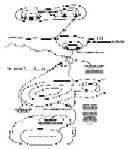against artillery fire, attack by ground forces, and air
attack; which permit maximum utilization of the terrain
for concealment and cover and for protection against attack
by armored forces; and which enable the company commander
to maintain control of his company. Consequently,
platoons will be separated laterally, or in depth, or both.
On open terrain, platoons may be separated by as much as
300 yards. In woods, distances and intervals must be decreased
until adjacent units are visible, or, if the woods
are dense, connecting files or groups must be used between
platoons. The company commander does not usually prescribe
the formation to be taken within platoons but promptly
corrects any erroneous formation taken by them. For platoon
dispositions, see paragraphs 106a and 170b.
- The company commander, assisted by members of the
command group, conducts continuous personal reconnaissance
to locate the best covered routes of advance. Shelled
and gassed areas, those exposed to hostile small-arms fire, and
points (such as villages, defiles, road junctions, and small
woods) likely to have been registered upon by hostile artillery
are avoided, if practicable. If areas swept by fire cannot
be avoided, they are crossed by rushes of individuals or
small groups under control of subordinate leaders. The
company commander may decide to cross dangerous areas
(such as roads, crests, or embankments) which are not actually
under fire by a rush of the entire company. Otherwise
he signals platoon leaders to have their platoons proceed
individually.
- Irrespective of the company's position in the battalion
formation, guards are necessary to give warning of air or
mechanized attack. The company commander's initial order
assigns sectors of observation to platoons to provide continuous
all-around observation. See paragraph 9c for action
against hostile aircraft and mechanized vehicles.
-
- Regardless of whether or not other forces are in
front of the battalion during its approach march, the battalion
and the company are responsible for protecting themselves
and conducting reconnaissance to the front and flanks.
The approach march of the battalion may be conducted with
one or more companies in the leading echelon. A leading
















